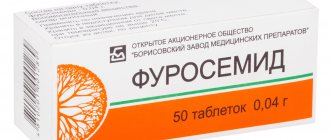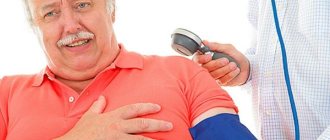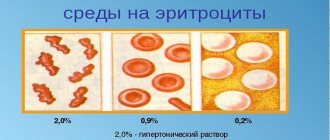A sympatho-adrenal crisis, also called a panic attack, is one of the manifestations of VSD (vegetative-vascular dystonia) of the hypertensive type.
This condition is not a disease, but a condition that manifests itself in the form of an acute attack, which is accompanied by an increase in heart rate, chest pain, a sharp rise in blood pressure, as well as an emotional feeling of fear.
The most common time for a crisis to occur is the second half of the day or night.
This fact is explained simply - during the day the body accumulates both physical and emotional fatigue, which can cause a panic attack.
Read more about panic attacks in our materials:
Causes
There can be many predisposing factors and causes for a crisis to occur in the sympathetic system. The main trigger is the release of adrenaline into the bloodstream due to a malfunction in the peripheral nervous system.
Predisposing factors:
- negative habits - abuse of alcohol and tobacco products;
- psycho-emotional stress;
- severe stressful situations;
- hormonal fluctuations - in adolescents, in elderly people;
- human neuroinfections;
- pathologies of the digestive and urinary system;
- cardiovascular diseases;
- vascular diseases – atherosclerosis;
- obesity;
- Personal characteristics – increased anxiety;
- history of traumatic brain injury;
- negative hereditary predisposition.
Some of the reasons a person can prevent are high cholesterol levels and physical inactivity. While others, for example, endocrine diseases of the adrenal cortex, are not amenable to preventive measures.
The first adrenal crisis requires immediate consultation with a doctor and a comprehensive medical examination. Once precipitating conditions are identified and addressed, the incidence of ill health can be minimized.
Vegetative crisis: symptoms and causes
The cause of panic attacks can be diseases of the endocrine, nervous, and cardiovascular systems. The psychological state of a person and the social situation around him are important. Frequent negative emotional outbursts, depression, and lack of sleep can cause such a deviation. Possible hereditary influence. Lifestyle and bad habits are one of the reasons for the crisis. May be caused by taking certain medications. Most often it occurs at the age of 20-30 years, and also after 65, more typical for women.
Clinical picture
Signs of an adrenal crisis can often be observed after a person has suffered physical or psycho-emotional stress - in the second half of the day. Sometimes even at night. Any harbingers are unusual for him.
For a typical sympathoadrenal crisis, symptoms will include:
- in the chest area there is a feeling of pressure, squeezing - from barely noticeable discomfort to bursting, burning pain;
- moderate increase in body temperature;
- blood pressure – rises sharply and quickly to individually high values;
- a feeling of lack of air - a person experiences breathing problems in the form of an inability to breathe deeply;
- heartbeat is rapid, sometimes arrhythmias appear;
- sweating - the outer skin becomes covered with sticky sweat, especially in the area of the feet and palms;
- acute urinary retention;
- increasing fear of death;
- chills;
- pain in different parts of the head.
After the main symptoms of an adrenal crisis have subsided - after a minute or half an hour, people continue to feel weak and want to rest and sleep. In the future, with frequent failures of the sympathetic system, patients feel embarrassed and develop a tendency to depression. This contributes to disruption of social adaptation – problems at work, in the family.
Symptoms
Symptoms of this condition usually develop after severe stress, after physical and mental fatigue.
The main symptoms are:
- Feelings of pain, pressing or squeezing in the chest and heart;
- Rarely elevated body temperature;
- High blood pressure;
- Dry mouth;
- Spasm of the blood vessels in the arms and legs, causing them to become cold to the touch;
- Exophthalmos;
- Rapid heartbeat (arrhythmias);
- Chills;
- Headache;
- During the crisis, urine retention occurs;
- Fear of death and feeling of horror;
- Increased sweating;
Diagnostics
Up to 2/3 of the diagnosis of adrenal crisis in a person requires a thorough history taking by a specialist. For example, when the disorder appeared, what preceded it, there were similar conditions in the family. To find out the causes and initial diseases, the doctor will suggest diagnostic procedures:
- electrocardiogram – paroxysm in heart rhythm;
- ECHO KG – anatomical condition and its deviations in the chambers of the heart;
- brain tomography – presence of tumors;
- taking cerebrospinal fluid from the spinal canal to exclude neuroinfections;
- blood tests - general, biochemical, and also for tumor markers;
- Ultrasound and hormones of the thyroid gland, as well as adrenal glands.
Since adrenal crises often occur against the background of diencephalic syndrome, it is impossible to do without consulting an endocrinologist. An examination by an ophthalmologist and a neurologist will also be required.
Only after analyzing all the information from laboratory and instrumental diagnostic methods, the doctor will be able to get the whole picture about the state of a person’s health and make his qualified opinion. Without this, it is impossible to select an effective treatment regimen.
Theories of panic attacks
Scientists have put forward several versions explaining the processes that start and occur in the body at the time of sympathoadrenal crises. They can be considered both the causes of attacks and the pathogenesis of the condition.
Cognitive theory
It is based on a person’s misinterpretation of his feelings. For example, the heart rate increases due to physical exertion or fear, but he perceives this as a threat to life. People begin to exaggerate their sensations, saying that these are harbingers of death. As a result, they panic. Most often, the symptoms are mild; the state of anxiety due to the anticipation of an attack is more disturbing.
Genetic theory
It is believed that sympathoadrenal crises may have a genetic basis. There are studies that confirm that panic attacks are encoded in the genetic material and appear when provoking factors appear. According to statistics, 20% of those suffering from panic attacks have relatives with a similar condition. If one of the identical twins suffers from a crisis, then the probability that it will develop in the other is 50/50. This theory has not been fully proven.
Psychoanalytic theory
Based on the theory of Sigmund Freud, who argued that anxiety states develop against the background of suppressed conflict within the individual. If a person does not discharge emotionally, including sexual energy, then all suppressed emotions begin to hide inside the person. Over time, hidden emotions develop into anxiety states at the mental level and manifest themselves in the form of panic attacks. Freud's students support his hypothesis and agree that not only sexual desire can lead to a crisis, but also certain social prohibitions in terms of sexual life.
Behavioral theory
The theory is based on a person’s fears that appear in certain situations, which are one of the signs of a panic attack. For example, when getting into a car, train or plane, a person perceives the trip as a threat to his life, as it represents a possible plane crash. Because of these thoughts, panic sets in. A similar situation often occurs in people with heart disease and mental disorders.
Catecholamine theory
Scientists have established a connection between the crisis and high levels of catecholamines in the blood. These substances belong to hormones that are synthesized in the adrenal cortex. Normally, they are released into the blood during stressful situations, danger, or excessive tension. Catecholamines stimulate the body to protect against external influences and increase endurance. Hormones increase the rhythm of the heart and breathing so that the blood moves faster, blood pressure increases, and the activity of nerve cells in the brain is stimulated.
If at rest (in the absence of danger or stressful situations) the production of catecholamines increases, then the likelihood of developing a panic attack increases. To prove the theory, scientists conducted experiments: they injected adrenaline into the veins of experimental subjects. After administration, emotional and physical signs of sympathoadrenal crisis occurred.
Treatment tactics
In general, therapy for adrenal crises is the identification and elimination of all possible provoking factors. Undoubtedly, a person will have to reconsider areas of his life - adjust his work and rest schedule, diet, as well as individual habits.
The diet recommends a predominance of vegetable and fermented milk dishes, while foods that negatively affect the functioning of the peripheral nervous system are best excluded. These include sauces and seasonings, spices and smoked meats, sharp cheeses and chocolate.
If you are prone to sympatho-adrenal crises, adequate physical activity is encouraged - visiting fitness centers, swimming pools, long walks. As a result, people’s bodies produce “happiness hormones” – endorphins, which have a positive effect on the sympathetic system.
The need to be treated with pharmaceuticals arises if adrenal crises recur, and the above measures do not bring relief. Main subgroups of medications:
- herbal sedatives;
- beta blockers;
- tranquilizers;
- selective antidepressants.
The specialist selects the optimal doses and drug regimens on an individual basis. It is prohibited to independently resort to the use of pharmaceutical drugs for adrenal disorder - the risk of complications is high.
Additionally, psychotherapeutic treatment is definitely recommended - conversations with a qualified specialist, during which people realize and work through their fears and internal problems. The result is a decrease in the number of adrenal crises or their milder course.
What to do during sympatho-adrenal crises?
Tips for when a crisis occurs:
- As soon as the patient begins to notice that a crisis will soon occur, it is necessary to remain completely calm, relax, and, if necessary, ask for support and help.
- If the crisis has already occurred , then you should also remain calm, avoid factors that provoke anxiety, you should try to regulate your breathing, and lie down.
- If the patient is taking medications that soothe and help with this condition, then take the medicine immediately.
- You can go outside and breathe fresh air , which can alleviate the condition and relieve headaches and difficulty breathing.
- If it becomes too severe and the condition is not controlled, then you should call an ambulance .
Urgent Care
It is not difficult to understand that a person needs emergency medical care in a situation of adrenal crisis - by external signs. However, the patient himself must report that this is a failure in the sympathetic system - they have already happened to him.
First aid for an attack due to adrenal failure before the arrival of medical workers:
- try to calm the person down - talk about abstract topics;
- unfasten tight clothes, tight belt;
- provide fresh air access to the room;
- perform several breathing movements;
- drink some clean water without gases;
- measure blood pressure and, if it is high, give the drug that a person usually takes for hypertension;
- breathe into the bag - it has a calming effect on the patient;
- Wipe exposed skin with a damp cloth.
If emergency care does not bring the desired result - the person’s condition remains poor, then specialized consultation from a specialist cannot be avoided. As a rule, visiting emergency doctors administer injections of sedatives and antihypertensive drugs.
Senior crises
Hypertensive crisis occurs in patients at an older age and develops as a result of usually long-term arterial hypertension. It comes in two types, which are determined depending on the mechanism of its formation, and in some cases it threatens with serious complications (complicated crisis).
It is not difficult to guess that the main characteristic of a hypertensive crisis is a rise in blood pressure. Its causes, in addition to autonomic disorders resulting from stress and neuroendocrine disorders, can be structural changes in the vascular wall caused by cholesterolemia (increased cholesterol levels due to low and very low density fractions). Atherosclerotic plaques formed on the vascular walls lead to narrowing of blood vessels and their inability to adequately respond to the environment (psychological, meteorological, etc.)
Progressive hypertensive and atherosclerotic changes in brain tissue are often the cause of cerebral crisis, which manifests itself as an acute, but transient, disorder of cerebral circulation within a day.
Read more about hypertensive crisis and help with it by following the link.
The main culprits in the occurrence of dynamic cerebral circulatory disorders are considered to be microemboli carried by the bloodstream into small-diameter cerebral vessels. Microemboli are formed from cholesterol crystals, red blood cell aggregates, platelet conglomerates, and atheromatous plaques. Also, the cause of brain disorders can be vertebrobasilar insufficiency, which is often a consequence of significant changes in the cervical spine due to osteochondrosis.
Cerebral crisis has several other names. In various sources it may be called a transient ischemic attack or ischemic crisis, but its essence does not change, and the clinical picture will be represented by the following manifestations:
- Dizziness and headache;
- Nausea and vomiting;
- Stunning and disorientation in space;
- Unilateral paresthesia of the upper or lower limb (not obligatory, but possible);
- Difficulty or absence of speech (sometimes), which recovers within a few hours.
Prevention of complications
Of course, an adrenal crisis does not go unnoticed for people. Especially in the absence of timely treatment for those diseases that became its root cause. After the attack ends, the person is recommended to make an appointment with a specialist and undergo examination followed by treatment.
Complications of adrenal crisis:
- hemorrhage in the brain structures;
- severe encephalopathy;
- unstable form of angina - with frequent arrhythmias;
- swelling of lung tissue;
- acute cardiac failure.
Experts include all healthy lifestyle measures as primary measures to prevent adrenal crisis, as well as its complications:
- a full night's rest - in a well-ventilated area, at least 8-10 hours;
- daily long walks;
- proper nutrition - dishes with minerals and vitamins for the nervous system;
- refusal of alcohol, tobacco products, as well as synthetic energy drinks;
- minimize negative information - from the TV screen, computer, it is better to replace them by watching your favorite comedies, reading books;
- reduce stress levels - do not quarrel with colleagues and relatives.
The health of every person is in his hands. Since an adrenal crisis is only a symptom of a malfunction in the sympathetic system, it is completely preventable.











